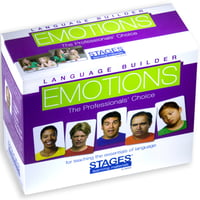10 Tips for Teaching Young Children with Autism Spectrum Disorder
Top Tips to Help You Get Started
All children have unique learning needs, but children with Autism Spectrum Disorder or ASD require a little extra guidance and support. Whether you’re a parent or teacher, it’s essential to understand what a child with autism needs and how you can help them learn better.
 FREE Download: 8 Language Builder Emotions Cards
FREE Download: 8 Language Builder Emotions Cards
These 10 tips will help you get started:
1. Create a Structured Environment – Children with autism feel more comfortable when they have a routine with clear structures, and minimal deviations from their predicted schedule. Make sure the learning environment and lesson plans are structured in a manner that tells students as well as educators what is to be done, for how long or how much, when it needs to be done, when it is completed, and what comes next.
2. Make Communication Easier – Many communication techniques are used by educators who teach children with ASD. For instance, some learning centers use sign language for autistic children with low speech skills. Facilitated communication is another technique that may help them learn better, where you hold the child’s hand or arm and encourage them to press the appropriate key on portable communication devices.
3. Use Visual Aids – Visuals are an important aspect of teaching young children, particularly for children with autism. Line drawings, photographs or Language Builder Picture Cards, “if/then” cards and stickers can be incorporated within various daily activities, while picture schedules and mini-schedules provide structure. Other tools such as online tutorials and videos deliver information in a visual manner that a child with ASD may find easier to absorb.
4. Encourage Social Interactions – You need to help children with ASD develop the knowledge and skills required for social interaction, both at home and in school. A child with autism may not seem interested in interacting with peers, parents and teachers, but it’s important to keep teaching them social skills. Classrooms provide the perfect setting, and childhood educators should build an environment that encourages children to practice communication skills. Try using the Stages Learning Emotion Cards to help children identify and learn to interpret facial expressions.
5. Make Activities Structured Too – Providing structure within various activities can be effective at helping children with ASD learn better. Use visuals to provide the child with information for each task or activity, in the same manner as lesson plans and daily schedules. For instance, a timer can tell them how long each activity will take. Include opportunities for peer interaction as well, to help children improve their social skills.
6. Use Direct Language – Young students with ASD may not understand abstract concepts or figurative language, and they tend to take most things literally. Non-verbal cues, such as facial expressions and gestures, may not make sense to them at all. If you’re used to teaching children who don’t have autism, it can take some time to get used to the right wording for what you want to say. Practice being as direct as possible.
7. Give Them Extra Time – Even when you use direct language, a child with ASD may not be able to respond or react right away. Give them extra time to absorb what you’ve said, and process it at their pace. Patience is a key when you’re teaching autism children. If you try to hurry the child or rephrase your instructions, statements or questions, you will only slow them down further as they start reprocessing.
8. Be Aware of Sensory Issues – Children with autism are either over-sensitive or under-sensitive to sensory stimuli the rest of us don’t even notice. For instance, they may be bothered by perfumes and other smells, certain lighting, or even the buzzing of electrical appliances and echoes from other areas. This leads to extreme reactions and from learning, so remain aware of potential triggers and avoid them as far as possible. Provide children with sensory tools to help them reduce stress and process information being communicated to them.
9. Eliminate Potential Stress – Children with autism don’t react well to changes and disruptions to their routine, so use transition warnings, visual schedules and clear instructions to help set them feel at ease. Remember, positive reinforcement is far more effective than threats or punishments, which are likely to cause anxiety and behavioral issues. Focus on building a positive learning environment where they feel safe and comfortable.
10. Keep Instructions Simple – Complicated strings of directions can be difficult for any student to follow, but particularly so for children with ASD. Many struggle with processing oral language, so you break down instructions step-wise, and avoid giving them more than one or two at a time. Make sure you’re using short sentences and simple but clear language, allowing the child enough time to process each step and respond.
Consult a doctor or therapist if you need guidance, research new techniques for teaching children with autism, and try a few different methods to gauge how effective they are for each child. Most importantly, don’t lose patience. With a little practice and effort, you’ll find what works best for them!
Additional Resources:
Parent Coaching: How It Works, What It Costs, & What to Expect

Dana Jandhyala
Making education simple and easy to comprehend is Dana Jandhyala's forte. She has had a long career as an educator where she has taught in several different schools and institutes in multiple countries. Today, she helps students with personalized online tutorials by MySchoolPage that help make concepts easy to understand, making learning fast and fun. She writes about helping students study better, and coaches parents so they can facilitate the success of their children.







